
Benitec Biopharma Reports Continued Durable Improvements in the Radiographic Assessments of Swallowing Efficiency and the Subject-Reported Outcome Instrument at the 180-Day Timepoint for First OPMD Subject Treated with Low-Dose BB-301 in Phase 1b/2a Study
-The post-dose average values for Total Pharyngeal Residue (i.e., the amount of solid food or liquid material remaining in the pharynx after the first swallow) remained meaningfully reduced at the 180-day post-dose assessment following the administration of the low dose of gene therapy BB-301 as compared to the pre-dose average values recorded for Subject 1 during the OPMD Natural History Study-
-Critically, for three of the four food types evaluated during the radiographic swallowing study assessments for Subject 1, the post-dose average Total Pharyngeal Residue values were lower at the 180-day post-dose assessments than at any point during the 9-month pre-dose observation period comprising the OPMD Natural History Study, with the post-dose average Total Pharyngeal Residue value for the fourth food type being similar to the lowest Total Pharyngeal Residue value observed at any point during the 9-month pre-dose observation period of the OPMD Natural History Study-
-The Total Score recorded for the subject-reported outcome instrument (i.e., the Sydney Swallow Questionnaire or “SSQ” Total Score) demonstrated continued reductions in the Subject’s dysphagic symptoms (i.e., improvements in the Subject’s ability to swallow) at the 180-day post-dose timepoint, with the Total SSQ Score continuing to decline and remaining meaningfully reduced as compared to the pre-dose average value recorded for Subject 1 during the OPMD Natural History Study, indicating a greater improvement in swallowing function as reported by Subject 1-
-Similar to the results observed for the radiographic swallowing study assessments of Total Pharyngeal Residue, the post-dose average Total SSQ Score was lower at the 180-day post-dose timepoint than at any point during the 9-month pre-dose assessment period of the OPMD Natural History Study-
-Key Opinion Leaders participating in the recent BB-301 Research and Development Day webcast (April 2024) highlighted radiographic swallowing study assessments of Total Pharyngeal Residue and the Subject-Reported Outcome SSQ Total Score as the central markers of value for the long-term evaluation of clinically meaningful improvement in subjects diagnosed with OPMD-
/EIN News/ -- HAYWARD, Calif., July 15, 2024 (GLOBE NEWSWIRE) -- Benitec Biopharma Inc. (NASDAQ: BNTC) (“Benitec” or “Company”), a clinical-stage, gene therapy-focused, biotechnology company developing novel genetic medicines based on its proprietary “Silence and Replace” DNA-directed RNA interference (“ddRNAi”) platform, today announces continued durable improvements in the radiographic assessments of swallowing efficiency and the subject-reported outcome instrument as assessed at the 180-day timepoint following the administration of the low-dose of BB-301 to the study’s first subject (Subject 1) treated in the BB-301 Phase 1b/2a single-arm, open-label, sequential, dose-escalation cohort study (NCT06185673) in Oculopharyngeal Muscular Dystrophy (OPMD). BB-301 has been granted Orphan Drug designation by the U.S. Food and Drug Administration (FDA) and European Medicines Agency (EMA) Committee for Orphan Medicinal Products (COMP).
The current interim clinical study update focuses principally on the 180-day results of the videofluoroscopic swallowing study (“VFSS”) assessments of Total Pharyngeal Residue (“TPR”, i.e., the amount of solid food or liquid material remaining in the pharynx after the first swallow) and the Subject-Reported Outcome Instrument (i.e., the Sydney Swallow Questionnaire or “SSQ”) as the Key Opinion Leaders (KOLs) participating in the recent BB-301 Research and Development Day webcast in April 2024 highlighted the Total Pharyngeal Residue and the SSQ as the central markers of value for the long-term evaluation of clinically meaningful improvement in subjects diagnosed with OPMD. Additionally, as the formal statistical plan for the BB-301 Phase 1b/2a clinical study comprises comparisons of the average pre-dose assessments to the respective average 365-day post-dose assessments for each subject, the interim clinical study update focuses on these specific quantitative comparisons. Benitec plans to provide additional analyses of the interim clinical study data at upcoming medical conferences and company-sponsored Research and Development-focused webcasts in the first quarter of calendar 2025.
“We are pleased to report continued positive interim clinical study data for Subject 1 in the investigational assessments deemed to be most critical for the evaluation of clinical benefit by the KOLs in the fields of OPMD research and patient care. Facilitating reductions in the quantities of solid food and liquid that remain in the throat post-swallow is believed to be a central indicator of improvement of swallowing and the reduction of the risk of aspiration in subjects suffering from OPMD,” said Jerel A. Banks, M.D., Ph.D., Executive Chairman and Chief Executive Officer of Benitec. “Our second BB-301-treated subject was dosed in February 2024, and we are poised to dose the third subject in the third quarter of calendar 2024. We remain on track to report additional interim clinical study results (representing at least 6 or 12 months of follow-up for each study subject) on multiple patients in the first quarter of calendar 2025.”
Background Information Regarding the Key Clinical Assessments and Outcome Measures:
TPR comprises the total amount of solid food or liquid material remaining in the pharynx after the completion of the first swallow of the bolus (Figure 1, from April 2024 R&D Day Slide Presentation). TPR is objectively characterized via the completion of videofluoroscopic swallowing studies which evaluate the complete swallowing process for each subject in the context of four food types (i.e., Thin Liquid, Moderately Thick Liquid, Extremely Thick Liquid, and Solid Food). The consistency of Thin Liquid is similar to that of water. The consistency of Moderately Thick Liquid is similar to that of a smoothie. The consistency of Extremely Thick Liquid is similar to that of yogurt or pudding.
The SSQ is a paper-based questionnaire assessing subjective symptoms of oropharyngeal dysphagia, and the questionnaire is completed independently by the study subject at each clinical study visit. The 17-item questionnaire measures the symptomatic severity of oral-pharyngeal dysphagia.
Figure 1 - VFSS TPR Assessments: Overview of the Radiographic Methods

BB-301 Interim Clinical Study Results for Subject 1:
Previously Announced 90-Day Post-Dose Interim Clinical Study Results
At the 90-day post-dose assessment following the administration of the low-dose of BB-301, Subject 1 demonstrated improvements in key VFSS assessments which correlated with the observation of similar levels of improvement in the SSQ as compared to the pre-dose average values recorded for Subject 1 during the OPMD Natural History Study, indicating an improvement in swallowing function as reported by Subject 1.
Newly Reported 180-Day Post-Dose Interim Clinical Study Results
The post-dose average values for TPR remained meaningfully reduced (i.e., smaller amounts of solid food and liquid material remained in the pharynx after the completion of the first swallow) at the 180-day post-dose assessment following the administration of the low-dose of gene therapy BB-301 as compared to the pre-dose average values recorded for Subject 1 during the OPMD Natural History Study (Figure 2). Critically, for three of the four food types evaluated during the radiographic swallowing study assessments for Subject 1, the post-dose average TPR values were lower at the 180-day post-dose assessments than at any point during the 9-month pre-dose observation period comprising the OPMD Natural History Study, with the post-dose average TPR value for the fourth food type being similar to the lowest TPR value observed at any point during the 9-month pre-dose observation period of the OPMD Natural History Study (Figure 2).
The Total Score recorded for the Subject-Reported SSQ also demonstrated continued reductions in the Subject’s dysphagic symptoms (i.e., improvements in the Subject’s ability to swallow) at the 180-day post-dose timepoint, with the Total SSQ Score continuing to decline and remaining meaningfully reduced as compared to the pre-dose average value recorded for Subject 1 during the OPMD Natural History Study, indicating a greater improvement in swallowing function as reported by Subject 1 (Figure 3). Importantly, similar to the results observed for the VFSS assessments of TPR, the post-dose average Total SSQ Score was lower at the 180-day post-dose timepoint than at any point during the 9-month pre-dose assessment period of the OPMD Natural History Study.
KOLs participating in the recent BB-301 Research and Development Day webcast (April 2024) highlighted VFSS assessments of TPR and the Subject-Reported Outcome SSQ Total Score as the central markers of value for the long-term evaluation of clinically meaningful improvement in subjects diagnosed with OPMD.
Figure 2 - VFSS TPR Assessments for Subject 1: Pre-Dose Average and 180-Day Post-Dose Average Assessments*
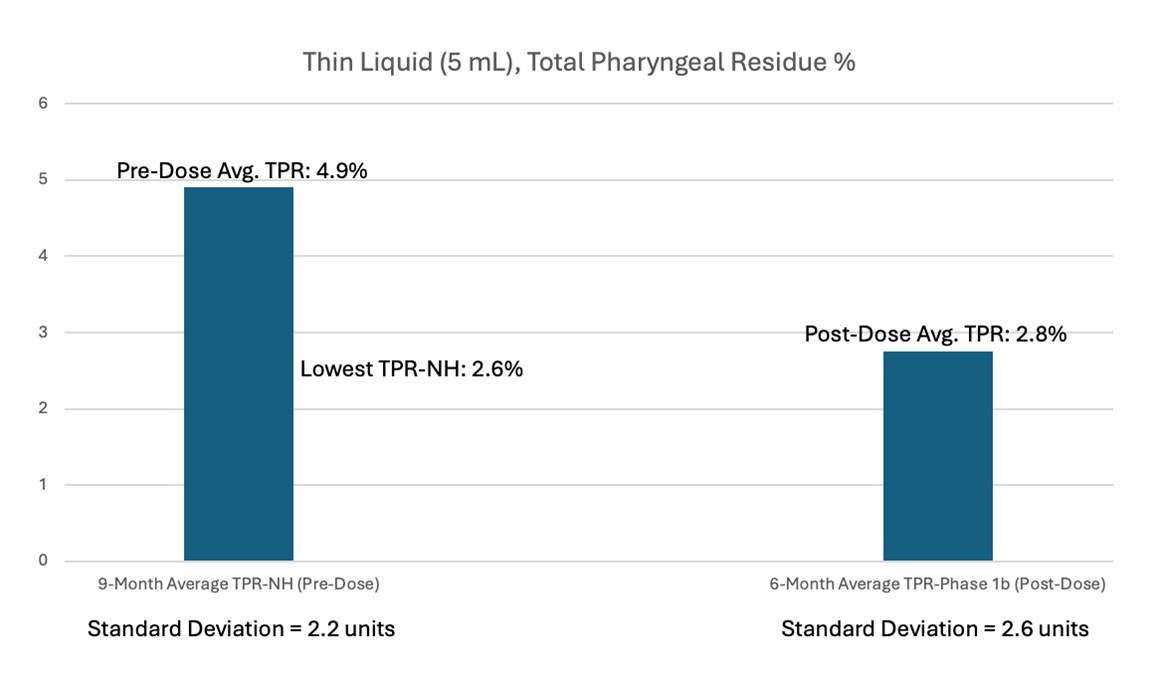
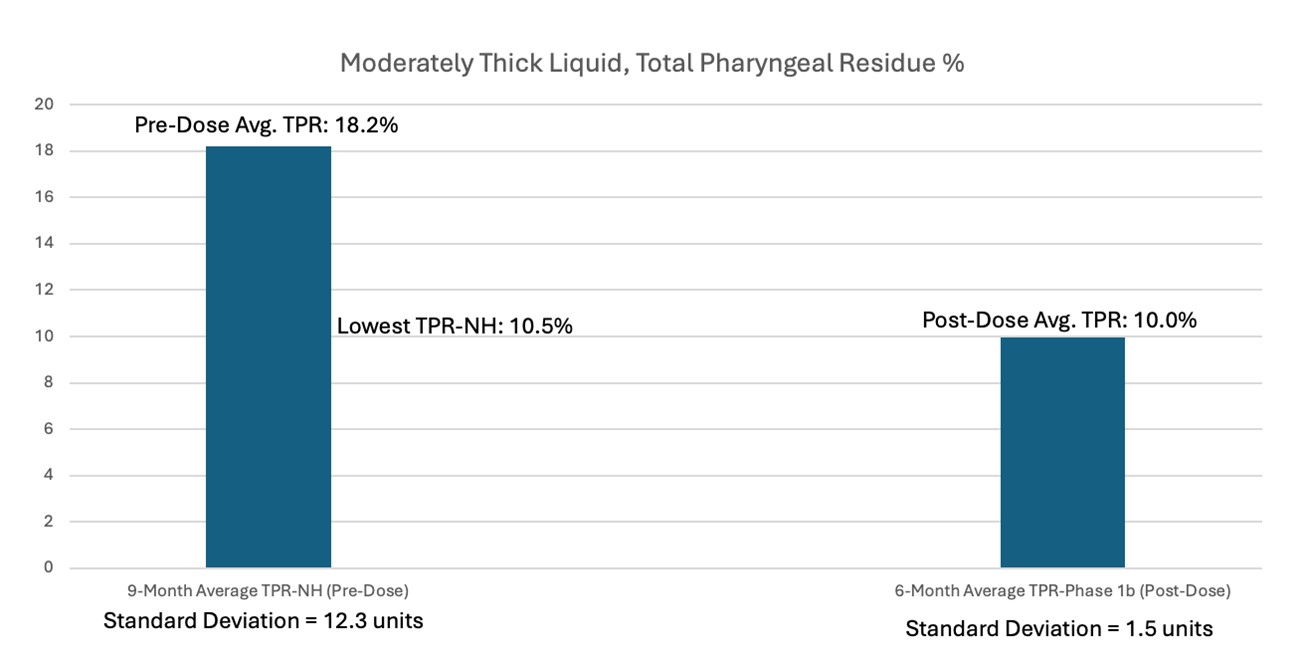
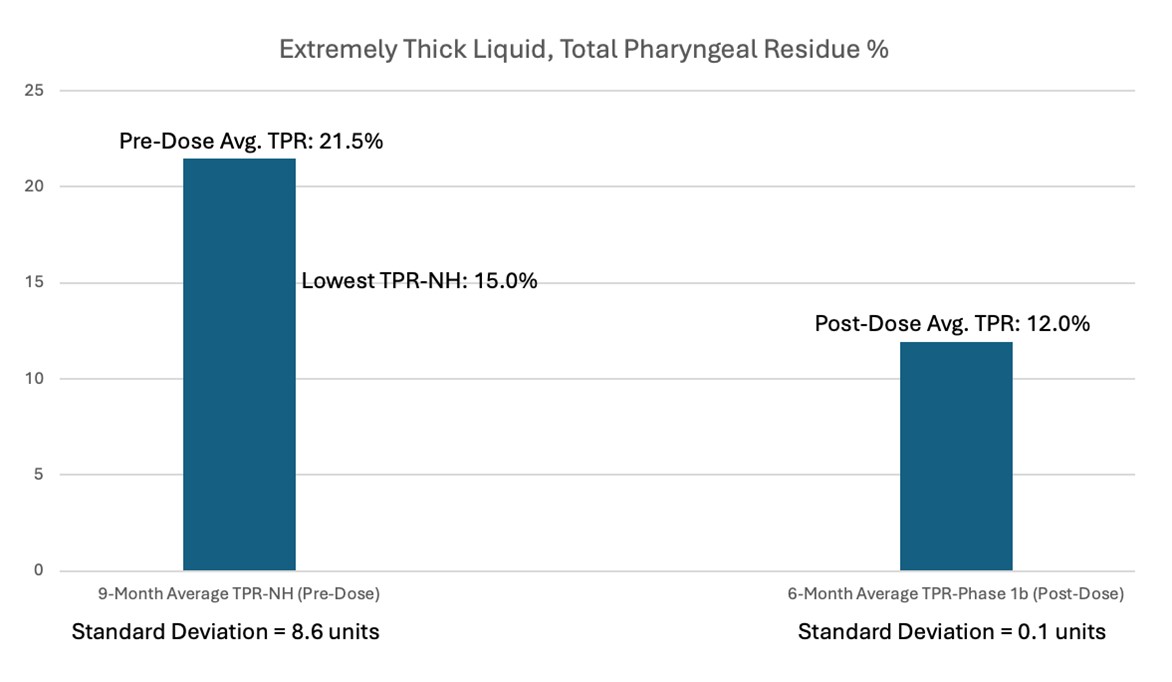
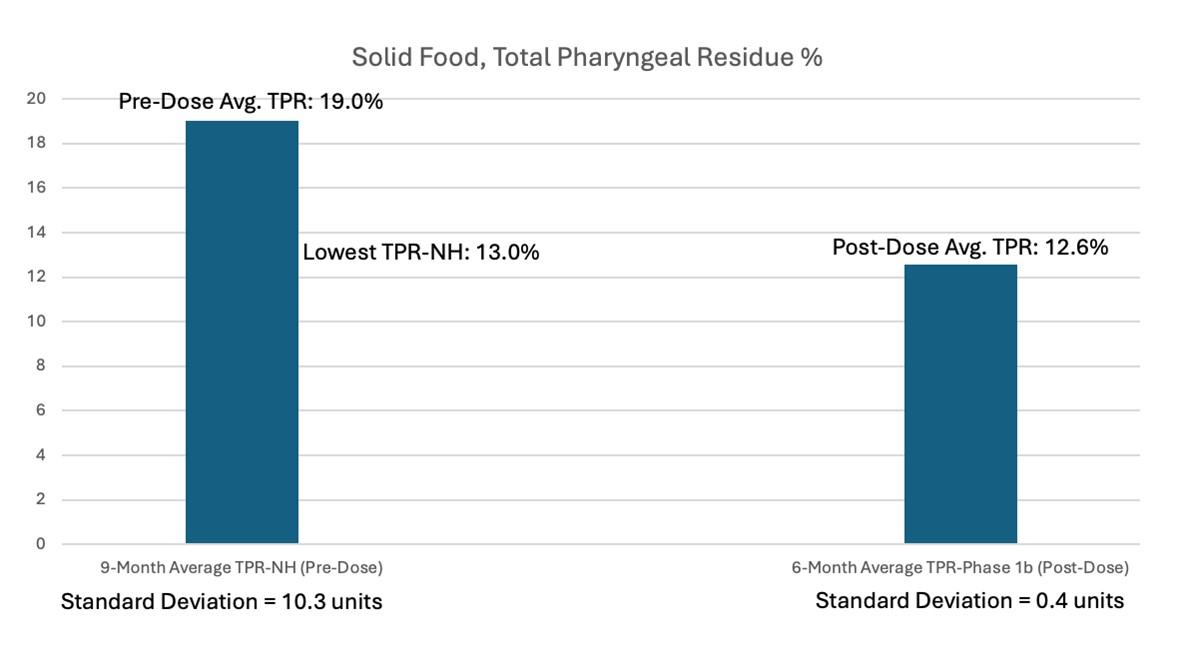
*Company data on file; Avg. = Average, TPR = Total Pharyngeal Residue, NH = OPMD Natural History Study
Figure 3 - Subject-Reported SSQ Total Score for Subject 1: Pre-Dose Average and 180-Day Post-Dose Average*
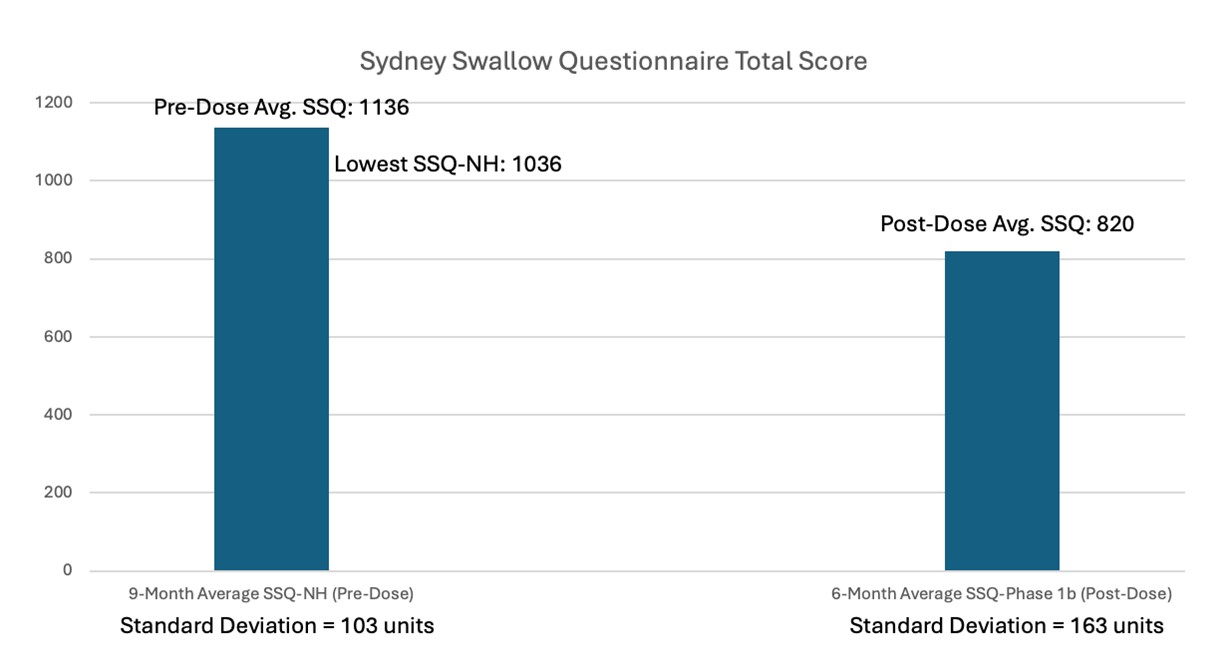
*Company data on file; Avg. = Average, SSQ = Sydney Swallow Questionnaire, NH = OPMD Natural History Study
Regarding the BB-301 safety profile observed to date, transient Grade 2 Gastroesophageal Reflux Disease or “GERD” (i.e., “acid reflux” or “heartburn”) has been reported previously in April 2024 at the time of the Research and Development Day webcast. No Serious Adverse Events (SAEs) have been observed for the two subjects that have received the low-dose of BB-301.
About OPMD
OPMD is a rare progressive muscle-wasting disease caused by a mutation in the poly(A)-binding protein nuclear 1 (PABPN1) gene, for which there is currently no effective drug therapy. The disease is characterized by swallowing difficulties (dysphagia), limb weakness and eyelid drooping (ptosis). Dysphagia worsens over time and can lead to chronic choking, regurgitation, aspiration pneumonia, and in severe cases, death. Available clinical and surgical interventions are limited in scope and effectiveness and do not address the underlying progressive muscle weakness.
About BB-301
BB-301 is a novel, modified AAV9 capsid expressing a unique, single bifunctional construct promoting co-expression of both codon-optimized Poly-A Binding Protein Nuclear-1 (PABPN1) and two small inhibitory RNAs (siRNAs) against mutant PABPN1. The two siRNAs are modeled into microRNA backbones to silence expression of faulty mutant PABPN1, while allowing expression of the codon-optimized PABPN1 to replace the mutant with a functional version of the protein. We believe the silence and replace mechanism of BB-301 is uniquely positioned for the treatment of OPMD by halting mutant expression while providing a functional replacement protein.
About Benitec Biopharma, Inc.
Benitec Biopharma Inc. (“Benitec” or the “Company”) is a clinical-stage biotechnology company focused on the advancement of novel genetic medicines with headquarters in Hayward, California. The proprietary “Silence and Replace” DNA-directed RNA interference platform combines RNA interference, or RNAi, with gene therapy to create medicines that simultaneously facilitate sustained silencing of disease-causing genes and concomitant delivery of wildtype replacement genes following a single administration of the therapeutic construct. The Company is developing Silence and Replace-based therapeutics for chronic and life-threatening human conditions including Oculopharyngeal Muscular Dystrophy (OPMD). A comprehensive overview of the Company can be found on Benitec’s website at www.benitec.com.
Forward Looking Statements
Except for the historical information set forth herein, the matters set forth in this press release include forward-looking statements, including statements regarding Benitec’s plans to develop and potentially commercialize its product candidates, the timing of completion of pre-clinical and clinical trials, the timing of the availability of data from our clinical trials, the timing and sufficiency of patient enrollment and dosing in clinical trials, the timing of expected regulatory filings, the clinical utility and potential attributes and benefits of ddRNAi and Benitec’s product candidates, the intellectual property position, and other forward-looking statements.
These forward-looking statements are based on the Company’s current expectations and subject to risks and uncertainties that may cause actual results to differ materially, including unanticipated developments in and risks related to: unanticipated delays; further research and development and the results of clinical trials possibly being unsuccessful or insufficient to meet applicable regulatory standards or warrant continued development; the ability to enroll sufficient numbers of subjects in clinical trials; determinations made by the FDA and other governmental authorities; the Company’s ability to protect and enforce its patents and other intellectual property rights; the Company’s dependence on its relationships with its collaboration partners and other third parties; the efficacy or safety of the Company’s products and the products of the Company’s collaboration partners; the acceptance of the Company’s products and the products of the Company’s collaboration partners in the marketplace; market competition; sales, marketing, manufacturing and distribution requirements; greater than expected expenses; expenses relating to litigation or strategic activities; the Company’s ability to satisfy its capital needs through increasing its revenue and obtaining additional financing, given market conditions and other factors, including our capital structure; our ability to continue as a going concern; the length of time over which the Company expects its cash and cash equivalents to be sufficient to execute on its business plan; the impact of the COVID-19 pandemic, the disease caused by the SARS-CoV-2 virus and similar events, which may adversely impact the Company’s business and pre-clinical and clinical trials; the impact of local, regional, and national and international economic conditions and events; and other risks detailed from time to time in the Company’s reports filed with the Securities and Exchange Commission. The Company disclaims any intent or obligation to update these forward-looking statements.
Investor Relations Contact:
Irina Koffler
LifeSci Advisors, LLC
(917) 734-7387
ikoffler@lifesciadvisors.com
Photos accompanying this announcement are available at:
https://www.globenewswire.com/NewsRoom/AttachmentNg/47b32ce8-e81a-4236-b68b-c0a5c15e109d
https://www.globenewswire.com/NewsRoom/AttachmentNg/7ac76152-dd9a-4e9a-a0fb-f11c1c30e5ce
https://www.globenewswire.com/NewsRoom/AttachmentNg/26fc77d9-a167-47ea-ba32-4f474da56716
Ahttps://www.globenewswire.com/NewsRoom/AttachmentNg/c3da2f6b-1a29-4748-900a-b8795423bbfe
https://www.globenewswire.com/NewsRoom/AttachmentNg/fbb05824-fc95-4774-b01e-c5e96384cf7b
https://www.globenewswire.com/NewsRoom/AttachmentNg/08fd3193-ac6c-4c0d-a7e8-0565f44725d4

Figure 1
VFSS TPR Assessments: Overview of the Radiographic Methods
Figure 2
Thin Liquid (5mL), Total Pharyngeal Residue %
Figure 2
Moderately Thick Liquid, Total Pharyngeal Residue %
Figure 2
Extremely Thick Liquid, Total Pharyngeal Residue %
Figure 2
Solid Food, Total Pharyngeal Residue %
Figure 3
Subject-Reported SSQ Total Score for Subject 1: Pre-Dose Average and 180-Day-Post-Dose Average*
EIN Presswire does not exercise editorial control over third-party content provided, uploaded, published, or distributed by users of EIN Presswire. We are a distributor, not a publisher, of 3rd party content. Such content may contain the views, opinions, statements, offers, and other material of the respective users, suppliers, participants, or authors.








